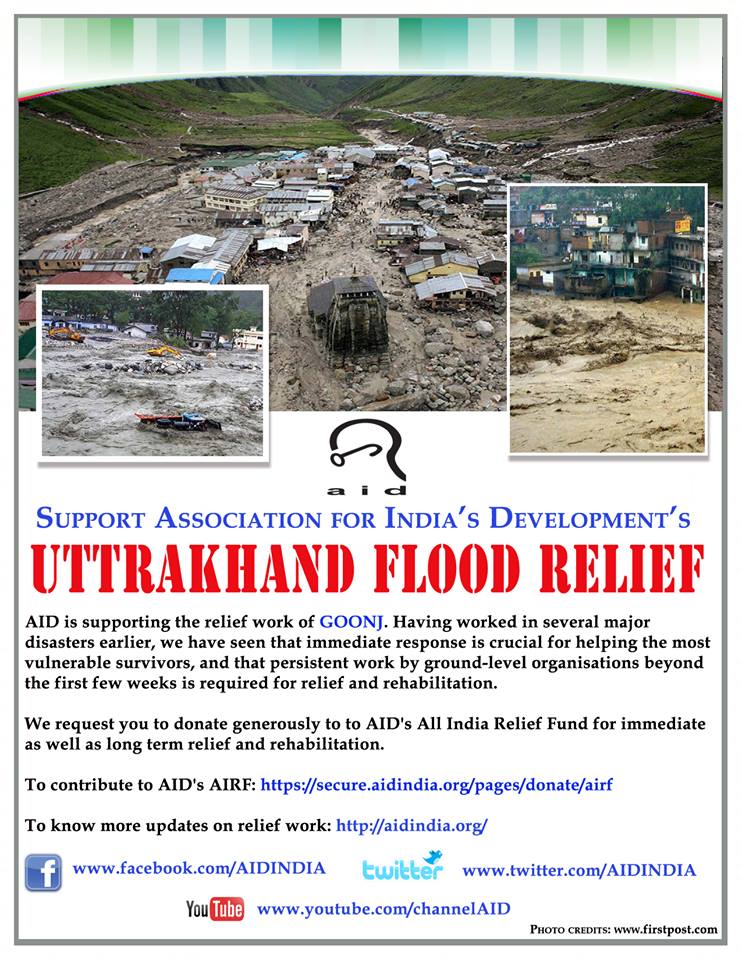Contribute
| AID's Response To The Disaster In Uttarakhand |
07/04/2013
The massive rainfall and flooding in Uttarakhand between June 16-18, 2013 has caused widespread death and destruction. Over 10,000 are feared dead by the estimates of National Disaster Management Authority in India and thousands missing. The full picture of death and destruction is slowly emerging.
Association for India’s Development (AID) responded immediately to the devastation in Uttarakhand by contacting its partners on the ground and sending them financial support. At the same time it sent out an appeal to the communities in the US to come forward and donate generously to support the work of relief and rehabilitation on the ground.
AID is a 22 year old volunteer driven organization with 35 chapters in the US working with its grassroots partners on 100 projects annually spread across India on issues of agriculture, health, ecology, women’s empowerment, social justice, and livelihoods. It promotes and initiates efforts in sustainable, equitable and just development in India.
From our experience of being involved in the relief and rehabilitation work after Orissa Super Cyclone (1999), Gujarat earthquake (2001), Tsunami (2004), Bihar Floods (2008) and Cyclone Aila (2009), we know that the process of rehabilitation takes several years and we are determined to work with our partners for as long as is needed. We also know that in a natural or human-made disaster, it is the marginalized sections that suffer the most and take the longest to get back on their feet.
The people of Uttarakhand as well as the volunteers of AID are thankful to those who have already contributed to its Uttarakhand & Himachal Relief and Rehabilitation fund. We further invite you to become partners of the people of Uttarakhand and share the appeal with friends and family.
In Uttarakhand, AID is supporting the work of People’s Science Institute (PSI), Himalayan Environment Studies and Conservation Organization (HESCO), Shri Bhuvaneshwari Mahila Ashram and Goonj who are doing immediate relief work in supplying food, water, clothes and basic medicines to areas that have been cut off but damaged roads and landslides. The media has provided in depth coverage of the areas around Char Dham where most of the tourists and pilgrims were stranded and affected. Close to 200 villages that have been badly affected has remained outside the media’s reach.
In a remote village in Pithoragarh 50 families lost their homes and land completely. After immediate relief, PSI is engaged in building temporary shelters that will last 3 to 5 years and will give the people enough time to get back on their feet and build permanent homes. Dr. Ravi Chopra from PSI and Dr. Anil Joshi from HESCO, both of whom have been widely quoted in the media are repeatedly advising us to be prepared for the long process of rehabilitation of lives and livelihoods. Malika Virdi with Himal Prakriti has also informed us about the large number of bridges, hydro power stations and dams that have been completely destroyed by the Gori river. Although the rainfall was very high over a short period of time, the erosive force of the river was much more than usual. “The crashing thunderous sound of boulders rolling under the water…is to be heard to be believedâ€, their report said.
The causes of a disaster of this magnitude are much more complex than just a natural one – the changing nature of rainfall, the kind of development and tourism that was developed in such a fragile ecosystem as the Himalayas that are considered to be the youngest mountain system in the world have all contributed in imparting lethality to the event. The Comptroller and Auditor General’s performance audit report of the disaster management authorities both at the national and state level point to a lack of preparedness. The state committee has not even met since its formation in 2007.
In AID we are gearing ourselves for the longer term to support our partners in the process of true rehabilitation that includes learning lessons from the disaster and thinking about a more sustainable model of development that is ecologically and socially sensitive.
AID once again would like to appeal to all communities to come forward and support the relief and rehabilitation process in Uttarakhand. Responding and learning from the disaster is not only important for the people of Uttarakhand but for the global community in general.
AID is calling on all concerned to generously support its relief efforts in India by making specifically directed contributions to its relief fund.
Donate Securely ONLINE Donate by CHECK:
Payable to: “Association for India’s Developmentâ€.
Memo: “All India Relief Fundâ€
Mail to: Association for India’s Development, 5011 Tecumseh Street, College Park, MD 20740, USA
You may also access this article through our web-site http://www.lokvani.com/
